Speech Language Pathology
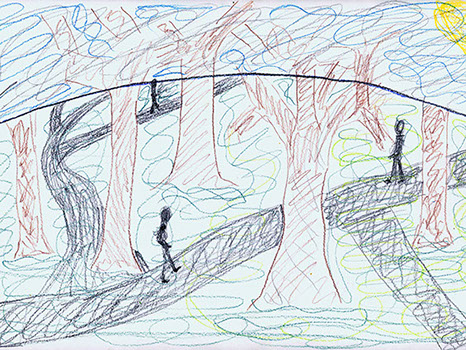

Home | Areas of Application
Language disorders affect all ages. The emotional component associated with these disorders plays a major role in the individual’s self-worth.
Language disorders directly affect communication often leading to guilt, shame, and a feeling of inadequacy, which can make rehabilitation challenging. The inability to communicate effectively can place an emotional burden on relationships, strain family dynamics and complicate parenting. All aspects of life are affected.
Speech therapy sessions can work very well to modify language deficits but sometimes the emotional impact of having a language issue is so strong that it is valuable to proactively address the emotional consequences first which will reinforce a positive self-image and promote more effective speech therapy sessions.
Using a creative process to improve the physical, mental and emotional well-being of people of all ages with language disorders can resolve internal conflicts, develop interpersonal skills (essential for communication), manage behavior, reduce stress and build self-esteem. It is important to remember that emotions play a major role in many language and speech disorders.
In our experience, we have seen people troubled with stuttering, mutism, a voice or writing disorder, and learning difficulties greatly benefit from the CAP process.
The programmed sessions help to better identify the emotional element associated with the symptom and eliminate blockages that hinder success with conventional therapy. CAP is a supportive adjunctive intervention which will in time reduce the number of speech therapy sessions needed to accomplish the patient’s goals.
CAP as an artistic mediated method which does not replace but complements speech therapy rehabilitation. It prepares the individual emotionally thus enabling the speech therapy session to be more effective. With CAP, we offer a highly structured system which unlike traditional speech therapy exercises offers another language - the symbolic language of drawing that has the ability to mobilize our inner potential while accelerating the rehabilitation process.
As an artistic mediation where verbalization is possible but not mandatory, the person summons an internal frame of reference, with the sole support of his or her feelings generated by the sound of the music.
Graphic expression triggers the sensory-motor, cognitive and emotional processes which has a positive impact on the one’s state of mind and consequently on his or her language. Indeed, drawing under musical induction engages not only one’s perceptions (of which he is not necessarily aware) but also feelings. Addressing those emotional and cognitive aspects that often accompany language disorders is essential during the healing process to achieve success.
CAP's programmatic music stimulates creativity, while soothing tension. The process avoids the need to critically evaluate one’s thoughts & actions which can often hamper progress, especially for children.
Writing a commentary to describe the drawing or to tell a story invites the person to travel into the surprising and wonderful world of language and gives those who desire to communicate an opportunity to express themselves.
ADVANTAGES & BENEFITS
And the most important benefit of CAP is the acceleration of the healing process, which helps reduce the time it takes to resolve a speech or language disorder.
“CAP has changed my life. I was suffering from a severe stuttering problem
that caused fear of social contact. It has been one year since I was in the CAP program and I must
say that the fear of stuttering is gone, and I have a more fluid speech. It helped me to come out of
the depth of loneliness which I had locked myself up in. I went back to college and I have returned
to a lively social life.”
— Martin (stuttering disorder)
Martin is in his thirties. He experiences a type of paralysis when he needs to speak. This disability prevents him from having a social life. He lives alone, almost never goes out, and his relationships at work are afflicted. When asked questions, Martin resorts to writing the answers to avoid talking to anyone,
He is overly sensitive when he is engaged in conversation and a simple frown is interpreted as a personal judgment that destabilizes him.
It was therefore necessary to find a method that does not involve speech, that is respectful of his personal boundaries, and would allow him to establish a relationship of trust with the therapist, while helping him to discharge these emotional tensions that paralyze him.
At first, an intervention with traditional speech therapy were not possible because he was unable to relax during the sessions. The tension in his body made it difficult for him to properly breathe and use his voice.
At first, Martin was very suspicious about engaging in the CAP sessions because he was so unease with his emotions. But he intuitively knew deep within himself that working on his emotions was crucial for his healing.
Martin arrived at his first CAP session, skeptical but determined. He thinks he can't draw. However, he listens to the music attentively, grabs the pencil, and starts drawing some circles and then vertical lines. He tries the brush, chooses a color, and as he listens, the sheet of paper is filled with painted trees. The branches intersect as if stirred by an invisible wind. The page becomes a forest, bursting with emotions! Both attractive and scary at the same time, an entire emotional world is revealed. Martin, who thought he could not express anything, even in painting, was surprised by his creation. It was a rewarding experience for him. In the drawings that followed he expressed himself with the same intensity.
As he drew hermetically sealed castles, deserted islands, pathways, and isolated houses, Martin expressed his inner confinement in the space on the sheet. Little by little, he freed himself from the internal conflicts that created isolation in his life. With this liberation, his speech become free as well!
Although the stuttering was still present, over time it gradually resolved. He found himself less tense, his body felt more relaxed, his breathing deepened, and he began to talk! And even if the words faltered at his lips, it didn’t matter, Martin kept talking.
From then on, Martin's life changed. He started going out with friend, he opened up to others and as he became more engaging, he left his lonely world behind.
At his request, he participated in CAP while he attended speech therapy sessions. CAP became his tool of expression. During this same period, he changed jobs and went back to school. His speech therapist helped him prepare for oral presentations and although the stuttering had not disappeared completely, it has diminished to the point were Martin could manage it easily.
A few years later, Martin came to the office to introduce a young woman to his CAP therapist. They're holding hands, like in his drawings!
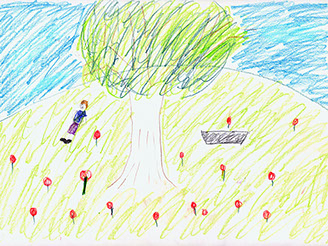
Reference Drawing #1
without music
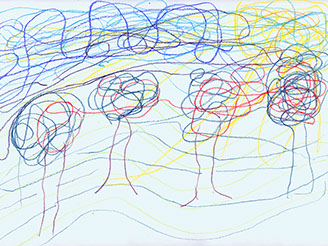
Drawing #1
with music
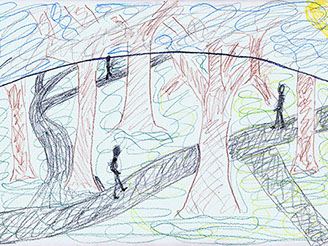
Drawing #2
with music
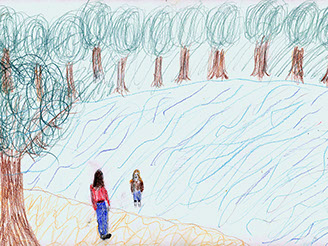
Drawing #3
with music
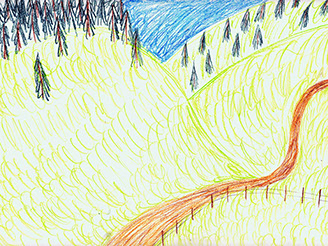
Drawing #4
with music
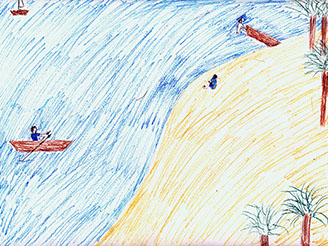
Drawing #5
with music
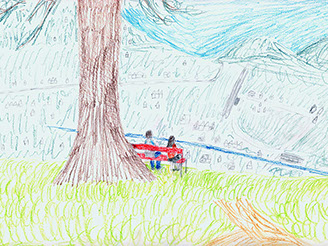
Drawing #6
with music
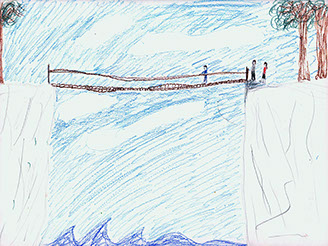
Drawing #7
with music
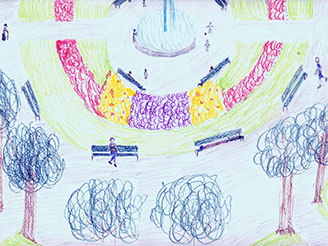
Drawing #8
with music
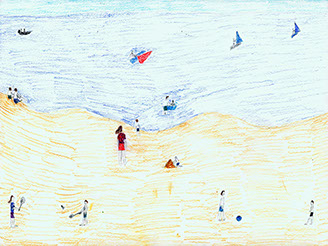
Drawing #9
with music
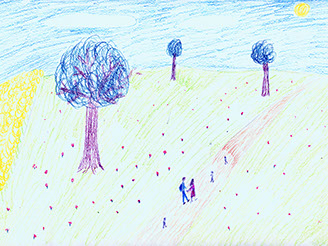
Drawing #10
with music
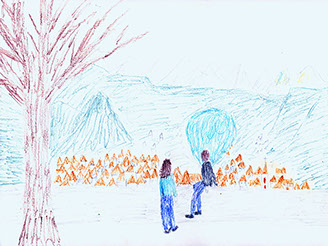
Reference Drawing #2
without music